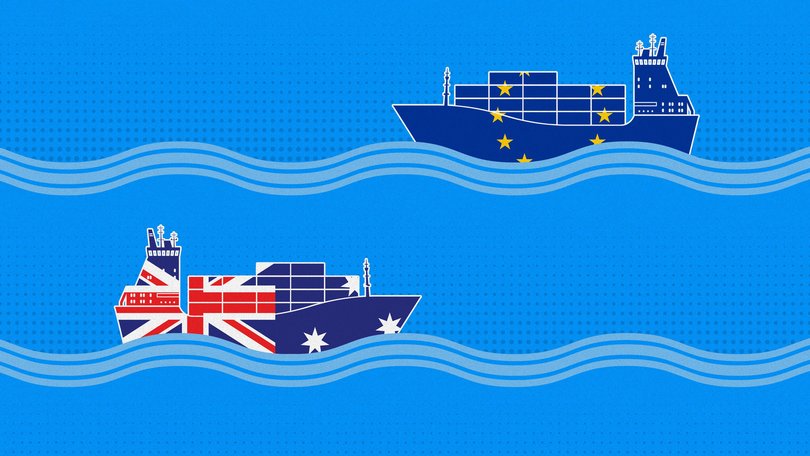European Union free trade agreement with Australia now in sight amid Trump tariff turmoil

Australia is within striking distance of signing a free trade agreement with the European Union, a deal that would send a clear message to other trading nations about the importance of a global rules-based trading system.
Last night, Trade Minister Don Farrell told The Nightly’s Latika Bourke that now was the time to “strike while the iron is hot”.
A deal that has been in the works since 2019 is “99.95 per cent” complete, according to Dr Prudence Gordon, executive director at the Australian Centre for Trade and Investment and a former adviser to two trade ministers.
Sign up to The Nightly's newsletters.
Get the first look at the digital newspaper, curated daily stories and breaking headlines delivered to your inbox.
By continuing you agree to our Terms and Privacy Policy.“They were ready to sign when Farrell met (then EU trade commissioner Valdis) Dombrovskis, and everyone was surprised that they didn’t sign then,” Dr Gordon said.
The sticking point then, as now, is primarily agriculture.
The EU argues it should have exclusive rights to the use of regional product names such as prosecco and feta.
Both sides want greater access to each other’s food markets, which face a combination of tariff and non-tariff barriers, including quotas and rules around genetically modified organisms and deforestation.
There was also a minor disagreement over labour rights.
But in light of the current trade turmoil created by the Trump administration, Dr Gordon expected both parties to be more accommodating.
“In this new Trump era, if we can’t be more flexible — if the European Union and Australia can’t be more flexible — then things are looking grim for the global trading system,” she said.
Prime Minister Anthony Albanese said the disruption in global trade was a motivating factor for both parties to reach an agreement, but that Australia would not cave if its conditions weren’t met.
“I think the last time around, there was not a good enough deal for Australia,” the Prime Minister said.
“If it benefits us, we will be in it. If it doesn’t, we will continue to not sign up to something that is not in our national interest.
“So, we have had discussions as well with farming groups and the agricultural sector.”
As Australia’s third-largest trading partner after China and Japan, the European Union accounts for 8.7 per cent of bilateral trade last year.
Two-way trade reaching $106.2 billion in 2023. However, the relationship is markedly imbalanced in the EU’s favour. Australia exported $25.5 billion in goods and services to the EU last year, comprising $17.8 billion in goods and $7.7 billion in services, while importing $80.7 billion, including $62.7 billion in goods and $18.0 billion in services.
Australia’s top exports to the EU were dominated by raw commodities, including $7.6 billion in coal and $2.1 billion in oilseeds such as canola. Other major exports included professional and technical services, personal travel and education-related travel. In contrast, imports from the EU included $5.9 billion in passenger motor vehicles, $5.2 billion in transport services and nearly $9 billion combined in pharmaceuticals and medicines. European civil engineering and industrial equipment also featured heavily.
An FTA is conservatively estimated to boost Australia’s GDP by between $4.8 billion and $7.4 billion by 2030, according to the European Australian Business Council. The agreement is expected to eliminate around 98 per cent of tariffs, cut red tape for cross-border business, and include the most ambitious mutual recognition of qualifications the EU has ever offered.
Jason Collins, chief executive of the European Australian Business Council, said the benefits would be immediate and tangible for Australian consumers.
“This FTA will make a really significant difference in that it has been negotiated for changes to occur right across the entire economy,” he said.
“If you buy a European car, you’re paying a tariff of up to five per cent. If you import that same car from Japan or China, there’s no tariff.
“We’re taxing a whole lot of inputs into the domestic economy — from vehicles to industrial and even food-processing equipment — and we’re not protecting any industries by doing so. An FTA will lift that burden and reduce the cost of living.”
The luxury car tax, a 33 per cent impost for vehicles over $80,567 and $91,387 for fuel-efficient vehicles might also go as part of a free trade deal.
Agriculture remains the sticking point
Agriculture remains the most politically sensitive and economically contested element of the Australia-EU free trade talks, with negotiations stalling in late 2023 after Australia rejected a deal it said failed to deliver meaningful outcomes for farmers.
National Farmers Federation president David Jochinke said recent global trade disruptions shouldn’t mean Australia lowers the bar.
“If anything, they prove how important it is to get this right,” he said.
The EU maintains an average tariff of 14.2 per cent on agricultural imports, significantly higher than the 4.2 per cent average for non-agricultural goods. For key Australian exports, the barriers are even steeper — dairy faces average tariffs of 32.3 per cent, sugar 27 per cent and meat 19 per cent. The EU also imposes 142 tariff-rate quotas that cap imports on many farm products, further frustrating Australian exporters. By some estimates, the EU’s total agricultural imports would be $31 billion higher if these tariffs were removed.
The EU farm lobby also wants to enforce rules that would prevent Australian producers from using names like Prosecco, feta and parmesan.
Compounding the challenge is the $US85b ($130b) in annual subsidies that EU governments transfer to their farmers under the Common Agricultural Policy. These supports distort competition and have long been a sore point in trade negotiations with agricultural exporters like Australia.
Mr Jochinke said while farmers welcomed signs of compromise, the pressure was now on the Australian government to ensure the final agreement delivered a strong outcome for the sector.
“This isn’t just any deal. It’ll shape trade between Australia and Europe for decades. That’s why it must be fair and balanced, with real gains for Australian agriculture at its core.”
EU regulations another concern
Farmer groups, and others, fear the heavy hand of European legislation may also tie them up in new red tape.
The EU has strict rules on land use for farmers, for example, and plans were afoot to penalise Australian livestock producers for any deforestation that occurred on their land. At one point, the industry faced rules that would see satellite imagery, calibrated to European conditions to evaluate the loss of vegetation native to Australia.
The EU has walked back that position in recent times and Mr Collins, who was in Brussels with the Trade delegation, said political ructions, including supply chain concerns as a result of the war in Ukraine had led to a change in thinking.
“Europe is now reviewing a lot of its ESG-related policy. I can say from here in Brussels it’s palpable how the sort of legacy of COVID, Ukraine, and now the upending of the global trade system has really forced a rethink in the way that Europe approaches many of these issues,” he said.
“In Brussels, competitiveness is now the absolutely overriding theme of the work of the EU. It’s not ditching environmental objectives, but it’s saying it has to be done in a way that’s sustainable in terms of economic security and prosperity. So it’s got to be completely twinned now with its economic strategies.”

